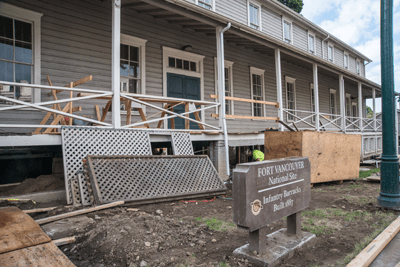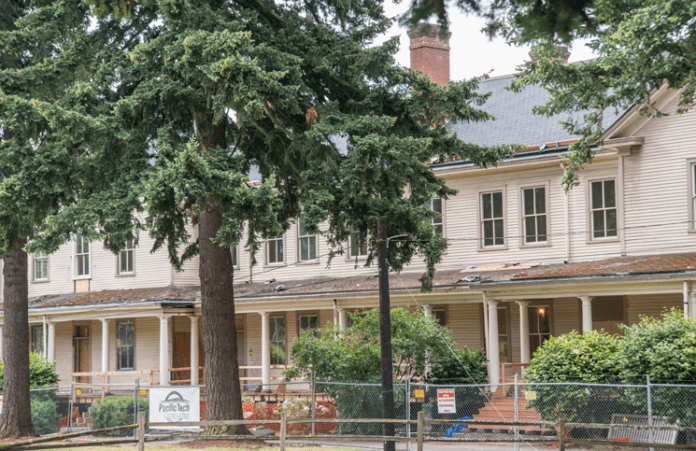With a shared vision to accurately preserve the Fort Vancouver National Historic Site (the only National Historic Site located in the states of Washington and Oregon), the National Park Service, the city of Vancouver and the Fort Vancouver National Trust are actively overseeing renovations that encompass several properties within the historic landmark.
As part of a master plan conducted after the Park Service took over the majority of the site from the Department of Defense in 2012, creating a sustainable and historic campus for public service is the primary mission. To that end, the Park Service is renovating buildings with an eye on a mix of tenants including federal agencies, commercial office space, nonprofit organizations and retail.
In partnership with the U.S. Forest Service, a $12 million project was recently completed on the south side of the parade grounds, and the regional radio dispatch center has moved in – just in time for fire season – with full Gifford Pinchot National Forest Headquarters relocation anticipated by the fall.
“Their (Gifford Pinchot) decision to come and be located at the national park was an exciting one,” said Tracy Fortmann, superintendent of Fort Vancouver National Historic Site. “Now there’s a forest service ranger that works at our visitor center. We’re doing a lot of co-marketing. Our missions are aligned.”
 Within the East and South Barracks are approximately 240,000 square feet of space in 28 buildings ranging in size from the double barracks at 30,000 square feet to smaller buildings that encompass 2,000 square feet. The era ranges from 1905 to 1941 with some more modern buildings located in the South Barracks dating from between the 1930’s to 1980’s.
Within the East and South Barracks are approximately 240,000 square feet of space in 28 buildings ranging in size from the double barracks at 30,000 square feet to smaller buildings that encompass 2,000 square feet. The era ranges from 1905 to 1941 with some more modern buildings located in the South Barracks dating from between the 1930’s to 1980’s.
Salvaging original fur floors is a priority wherever possible, while a complete overhaul of utilities and parking will create a balance of old world with modern amenities. The road network will be better designed for tenant and public access and special attention will be given to Alvord Road. Considered one of the oldest roads in the Pacific Northwest – if not the oldest – the campus thoroughfare will be repurposed as a hike- and bike-only path. Its incorporation will connect with the South Barracks, over the land bridge and down to the Columbia River waterfront.
In the West Barracks, four buildings are undergoing renovation. Kaare Hyde, facilities manager for the Fort Vancouver National Trust, broke down the activity.
A state-of-the-art heating and air conditioning system (VRS) is being installed in all the buildings to provide energy savings as well as upgraded mechanical, electrical, plumbing and refinishing of original floors.
At 21,000 square feet, the Fort Vancouver Artillery Barracks is the largest building being tackled by the Trust. Courtyard improvements and the raising of the back porch to be ADA-compliant will enhance future events.
The bulk of the work is being directed at the 7,500 square feet of Infantry Barracks. This was living quarters for infantry men, so it makes sense that they be converted into six one-bedroom and six studio apartments with one ADA-compliant unit. The west side main entrance will also be restored to its original location and grandeur, and a brand new roof will be added. Even the basement of this building will receive attention so that future tenants have space for bicycles and other personal items.
Mike True, president and CEO of the National Trust said, “We already have 30 people who’ve asked to be put on a waiting list with no advertising, so the demand is significant for these types of spaces.”
About $309,000 has been split between the two smaller buildings – dental surgery and quartermaster – 1,700 square feet and 1,800 square feet, respectively. These have been identified as office space or art galleries. Hyde added that historic interpretation pieces such as panels or curios will be placed wherever appropriate to tell the authentic story of the buildings and the Fort’s historical significance within the community.
Both the Park Service and the Trust are aware that tech companies, marketing, media and creative arts are a short list of industries that will be naturally drawn to the buildings. Increasingly popular co-working spaces are another option in light of the openness of the floor plans, historical preservation and abundant green spaces hosting a myriad of public activities throughout the week. Both agencies continue to stress that a mix of uses is the balance they intend to strike. A 98 percent occupancy rate along Officer’s Row further illustrates the appeal that well-maintained, historical buildings enjoy, according to True.
With a range of ages – from the circa 1887 Infantry Barracks to the 1904 Artillery, 1910 Dental surgery and 1914 Quartermaster – the essence of a simpler time is being integrated with the march of progress.
“The community has been waiting for these buildings to come available for use,” said True. “It’s been many years of planning and we’re excited this project is coming to fruition. A portion of this funding is from bonding through the city of Vancouver. Some are heritage bonds that the community purchases, so our community has invested in this project themselves [and] we’re excited to support this and see it come to fruition.”
For Park Service leasing space inquiries, contact Kristen Jontons, Vancouver Barracks Fort Vancouver National Historic Site National Park Service business manager, at 360.816.6209.









